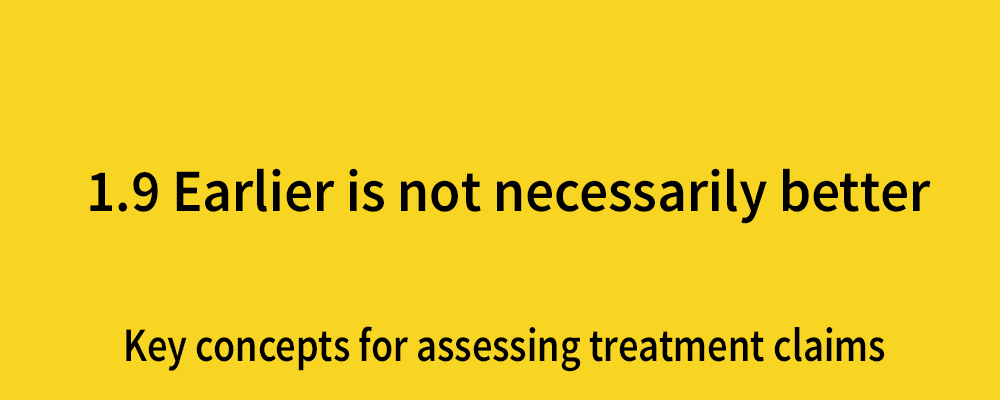Why don’t we screen for more diseases?
Posted on 29th April 2013 by Henry Greenslade

At first glance, deciding to screen or not to screen for diseases like cancer sounds like an easy choice. If we develop a test which can pick up a treatable disease early – it makes sense to use it as soon as possible – we would save both lives and money by treating it in its earlier stages. Unfortunately, as much as screening can save lives, it also has the power to cause much undue worry and suffering. How we decide what to screen for is based on evidence and statistics, and is a constant controversial topic in medicine.
What is screening?
According to the UK National Screening Programme [i],
“Screening is a process of identifying apparently healthy people who may be at increased risk of a disease or condition. They can then be offered information, further tests and appropriate treatment to reduce their risk and/or any complications arising from the disease or condition.”
Whilst there are many screening programmes available, those offered vary from country to country. (I would be interested if any students from outside the UK could share their countries policies on this, seems pretty hard to get hold of!) This is often due to the fact that while screening can provide benefits as described above, there is often a lot of potential for these programmes to cause harm to patients – as described below.
How good is the test?
Sadly nothing is perfect in medicine! Drugs have side effects, diseases can re-occur and relapse, and screening programmes cannot divide the population neatly into those with a disease and those who do not. Ideally we would like a test that could pick up all cases of a disease (true positive results) whilst not identifying people who are healthy as having the disease (false positive results).One of the main reasons that cancer screening generates a lot of controversy is due to this second point – a false-positive can generate fear and anxiety and may deter the patient from making further screening appointments [ii].
To use an UK example with prostate cancer – men can request a Prostate Specific Antigen (PSA) test and if the PSA is over a certain level – let’s say 4ng/ml – this is a positive PSA result and the patient can be referred for further tests. However because the test is not perfect – you will not catch every cancer. Take a population of 1000 men, 50 may have prostate cancer – but only 20 of these men have PSA levels over 4.
Only 20 out of 50 cancers have been identified by this test – giving a sensitivity of just 40%. The 30 men below 4ng/ml have received a false negative result. Meanwhile – for every 10 healthy men screened – 1 will have a PSA level over 4, and so will be wrongly identified as having the disease – a specificity of 90%.
As you can imagine – false positives and false negatives can have very profound effects on an individual patient, sent home with either a false reassurance or unnecessary tests.
As PSA levels in men are on a spectrum – there is a lot of overlap between healthy men and those with cancer.
If we lower the threshold – we catch more of those cancers that slipped under the net the first time – but we also lower the specificity – more healthy men will be referred for unnecessary tests.
At the same time – raising the ‘bar’ for the test means you can be more certain a patient with a positive test may have cancer, but you will also miss a lot more patients. This creates a bit of a balancing act, where the consequences of a false positive must be compared to consequences of a false negative – is it worse to miss the disease or cause undue worry and anxiety?
Do we know the disease well enough?
 The WHO criteria for screening [iii], states that the natural history of a disease should be well understood prior to screening. In other words – we should know our disease inside out – how it starts, and the events which mark it’s progression. Diseases such as cancer may never make themselves known if it wasn’t for screening. (I will promise to stop mentioning prostate cancer) but as an example most men will die with this disease than because of it. However we have no way of knowing what a tumour will end up doing when found as the result of screening – and this leads to a lot of over-diagnosis and over-treatment [iv].
The WHO criteria for screening [iii], states that the natural history of a disease should be well understood prior to screening. In other words – we should know our disease inside out – how it starts, and the events which mark it’s progression. Diseases such as cancer may never make themselves known if it wasn’t for screening. (I will promise to stop mentioning prostate cancer) but as an example most men will die with this disease than because of it. However we have no way of knowing what a tumour will end up doing when found as the result of screening – and this leads to a lot of over-diagnosis and over-treatment [iv].
This may result in dramatic therapies and investigations for example mastectomies in breast cancer – procedures that are not carried out lightly and which may be completely unnecessary. As well as the psychological impact of diagnosis and false positive results, the adverse effects of therapy are a considerable harm to the patient against the positives of earlier diagnosis and treatment.
The number needed to treat (NNT) is a good indicator of the benefit screening programmes can bring. For cancer – this is usually the number of curative treatments (surgery etc.) required to save an additional life vs. a non-screened population, and is another way we can look at benefits of screening.
Is screening making a real difference?
So we may have found the disease at an early stage – but does that have an impact on survival? It’s another requirement of the WHO classification and an important one. An important point is that whilst mean survival may increase on paper – people might not live for any longer.
For example, take two patients diagnosed with a disease. Patient A is diagnosed early in 2005 due to screening and lives 5 years after diagnosis, whereas patient B goes to the doctor 3 years later in 2008, when they first have symptoms, and only lives 2 years after diagnosis.
Whilst it looks like screening increases survival, it only means that patient A undergoes more treatment and possibly more worries for no gain in life years. However – identifying illness at an early stage may reduce complications and increase quality of life. Life years gained and quality of life gained can be combined into Quality Adjusted Life Years (QALY’S).
Conclusion
So screening is a complicated business. If you’re interested in the amount of diseases that we can screen for and how we decide what to screen for – check out http://www.screening.nhs.uk/ – whilst it’s UK-based it gives you a good idea of what diseases could be screened for and a summary of evidence for over 100 conditions.
Wilson and Jungner were two WHO scientists who published the first 10 criteria for a screening programme in 1968. The key themes are still used today, adapted as new technology (such as gene sequencing) has been developed and the criteria can be found here.
Hope this gets people interested in screening and the controversies behind it!
References:
[i] UK National Screening Committee. What is screening? http://www.screening.nhs.uk/screening (accessed 28/04/2013)
[ii] Bond M, Pavey T et al. Systematic review of the psychological consequences of false-positive screening mammograms. Health Technology Assessment 2013;17(13):1-170. doi: 10.3310/hta17130. (accessed 28/04/2013)
[iii] UK National Screening Committee. Why isn’t there a national screening programme for Prostate cancer in England? http://www.cancerscreening.nhs.uk/prostate/faq07.html (accessed 28/04/2013)
[iv] Bangma CH, Roemeling.S, Schröder FH. Overdiagnosis and overtreatment of early detected prostate cancer. World J Urol 2007; 25(1): 3–9. doi: 10.1007/s00345-007-0145-z. (accessed 28/04/2013)




No Comments on Why don’t we screen for more diseases?
Really good breakdown of screening issues Henry, using this as background for a debate I’m doing tomorrow against prostate ca screening
12th November 2013 at 4:45 pmGreat blog Henry!
29th April 2013 at 2:03 pmHave your read ‘Over-diagnosed’? Steve and Lisa the co-authors spoke at the Cochrane UK & Ireland Symposium this year about overdiagnosis through screening particularly in the US. It was really interesting – here is a link to the talk if you haven’t already seen it: http://www.students4bestevidence.net/the-challenge-of-over-diagnosis-over-treatment/
No hadn’t seen that will check it out, cheers!
29th April 2013 at 8:20 pm